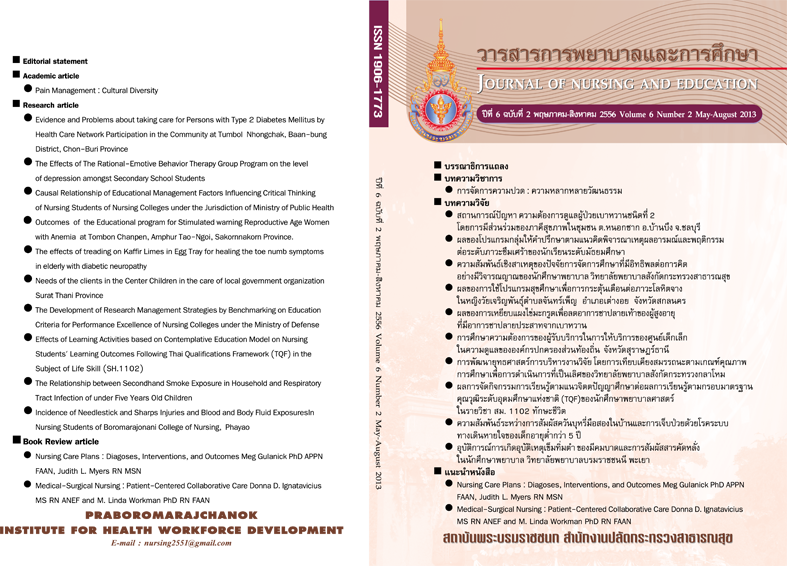ผลของการใช้โปรแกรมสุขศึกษาเพื่อการกระตุ้นเตือนต่อภาวะโลหิตจางในหญิงวัยเจริญพันธุ์ ตำบลจันทร์เพ็ญ อำเภอเต่างอย จังหวัดสกลนคร
คำสำคัญ:
anemia, reproductive aged women, educational program, and stimulated warningบทคัดย่อ
บทคัดย่อ
การศึกษาครั้งนี้เป็นการวิจัยเพื่อพัฒนาคุณภาพงาน มีวัตถุประสงค์เพื่อศึกษาประสิทธิผลของโปรแกรมสุขศึกษาที่จัดขึ้นเพื่อเพิ่มความรู้และเปลี่ยนแปลงพฤติกรรมของหญิงวัยเจริญพันธุ์ที่มีภาวะโลหิตจาง และเพิ่มระดับฮีมาโตคริตในหญิงวัยเจริญพันธุ์ที่มีภาวะโลหิตจาง ทำการศึกษาในหญิงวัยเจริญพันธุ์ที่มีภาวะโลหิตจาง บ้านนาหลวงและบ้านบึงสา จำนวน 17 ราย การดำเนินงานประกอบด้วย โปรแกรมสุขศึกษารายกลุ่มจำนวน 3 ครั้ง ห่างกันครั้งละ 2 สัปดาห์ เป็นระยะเวลา 6 สัปดาห์ (ระหว่างเดือน มิถุนายน
2553 - กรกฎาคม 2553) เก็บรวบรวมข้อมูลก่อนและหลังการให้โปรแกรมสุขศึกษา ประเมินผลโดยใช้แบบประเมินความรู้ แบบประเมินพฤติกรรมการป้องกันและแก้ไขปัญหาโลหิตจาง และแบบบันทึกค่าความเข้มข้นเลือด
ผลการศึกษาพบว่า
1. หญิงวัยเจริญพันธุ์ที่มีภาวะโลหิตจาง มีคะแนนความรู้หลังให้โปรแกรมสุขศึกษาและการกระตุ้นเตือนสูงกว่า ก่อนได้รับโปรแกรม (= 7.24, S.D. = 1.20 และ = 9.18, S.D. = 1.18 ตามลำดับ)
2. หญิงวัยเจริญพันธุ์ที่มีภาวะโลหิตจาง มีคะแนนพฤติกรรมการปฏิบัติตัวหลังให้โปรแกรมสุขศึกษาและการกระตุ้นเตือนสูงกว่า ก่อนได้รับโปรแกรม (= 21.41, S.D. = 1.66 และ = 22.47,
S.D. = 1.70 ตามลำดับ)
3. หญิงวัยเจริญพันธุ์ที่มีภาวะโลหิตจาง มีระดับความเข้มข้นเลือดภายหลังให้โปรแกรมสุขศึกษา และการกระตุ้นเตือนสูงกว่า ก่อนได้รับโปรแกรม (= 34.29, S.D. = 1.58 และ = 36.44, S.D. = 1.58 ตามลำดับ)
4. อัตราการเกิดภาวะโลหิตจางในหญิงวัยเจริญพันธุ์ ต่ำกว่าก่อนได้รับโปรแกรมสุขศึกษาและ
การกระตุ้นเตือนร้อยละ 6.83 (ก่อนเข้าโปรแกรมร้อยละ 23.5 หลังเข้าโปรแกรมร้อยละ 16.67)
ผลการศึกษาครั้งนี้แสดงให้เห็นว่าโปรแกรมสุขศึกษาและการกระตุ้นเตือน ช่วยแก้ไขปัญหาภาวะโลหิตจางในกลุ่มหญิงวัยเจริญพันธุ์ได้
คำสำคัญ : โลหิตจาง, หญิงวัยเจริญพันธุ์, โปรแกรมสุขศึกษา, การกระตุ้นเตือน
Abstract
This quality improvement research aimed to study effectiveness of the educational program for stimulated warning on knowledge, self - care behaviors, and the hematocrit level of reproductive aged women with anemia. Participants were 17 reproductive age women with anemia who lived in Ban Na-luang, and Ban Buengsa. Three sessions of the educational program with stimulated warning were provided for the participants consecutive week during six weeks
(June-July 2010). All of them were measured before and after participating in the program in term of the knowledge, behavior and heamatocrit level.
The results showed that:
1. The knowledge mean score of reproductive aged women with anemia after participating in the educational program with stimulated warning was higher than before participating in the program (before = 7.24, S.D. = 1.20, after = 9.18, S.D.= 1.18).
2. The behavior mean score of reproductive aged women with anemia after participating in the educational program with stimulated warning was higher than before participating in the program (before = 21.41, S.D. = 1.66, after = 22.47, S.D. = 1.70).
3. The reproductive aged women with anemia had hematocrit level after participating in the program higher than before participating in the program (before = 34.29, S.D. = 1.58, after = 36.44, S.D. = 1.58).
4. Anemia rate of reproductive aged woman with anemia was lower than before participating in the program = 6.83 percents (before = 23.50 percents, after = 16.67 percents).
Result suggested that providing this education programs with stimulated warning was solution for problem solving of reproductive age women with anemia in the of community.
Keywords : anemia, reproductive aged women, educational program, and stimulated warning.






